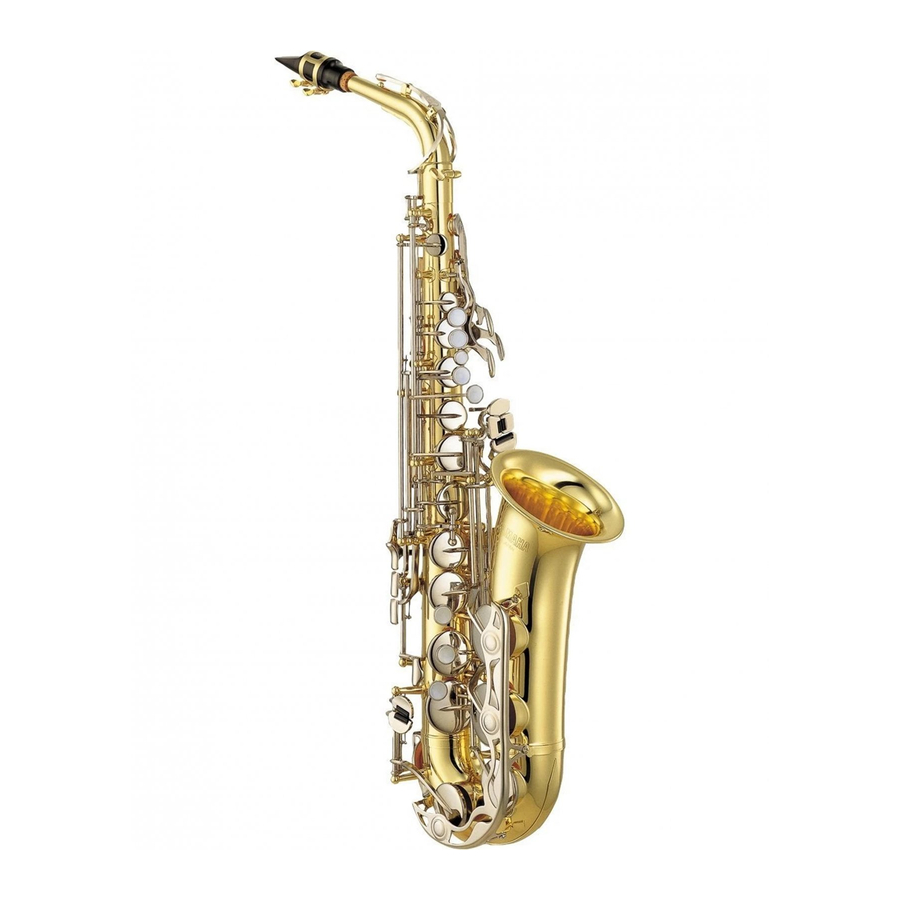
Summary of Contents for Yamaha YAS-23
- Page 1 Saxophone Owner’s Manual Saxophon Bedienungsanleitung Saxophone Mode d’emploi Saxofón Manual de instrucciones...
-
Page 2: Herzlichen Glückwunsch
P.19 Félicitations! Nous vous remercions d’avoir fait l’achat de cet instrument à cuivre Yamaha. En ce qui concerne les instructions relatives à un assemblage adéquat de l’instrument et sur la façon de garder l’instrument dans des conditions optimales aussi longtemps que possible, nous vous conseillons vivement de lire P.27... - Page 3 Saxophone Owner’s Manual Precautions Please read before using ■ About the Icons Disobeying the points indicated with this mark may lead Caution to damage or injury. ■ To obtain maximum life out of the instrument. ➞ ➞...
- Page 4 Nomenclature Alto Saxophone Soprano Saxophone Baritone Saxophone Tenor Saxophone * An alto saxophone is shown in the photo. Ligature Upper Bow Reverse Side Mouthpiece Neck Key Guard Neck Screw Water Key Octave Key Strap Ring Bell Thumb Hook * Improvements may change the design and specifications without notice.
-
Page 5: Assembling The Instrument
Assembly Before Assembling the Instrument Since the walls of the saxophone’s body are thin, it is important to remember not to put too much pressure on the instrument in any particular position when holding it. Also, be careful not to damage the instrument by using excessive force during assembly or while handling. ■... -
Page 6: Tuning The Instrument
Assembly ● Tuning the Instrument Attach the reed onto the mouthpiece. First, place the reed so that the tip of the Tuning is accomplished by adjusting the mouthpiece is seen over the end of the reed position of the mouthpiece on the neck. then tighten the ligature screws (two screws) Since air temperature or the temperature to secure the reed. -
Page 7: Instrument Maintenance
Instrument Maintenance ■ Instrument Maintenance After Playing After playing the instrument, use the following procedures to remove moisture and dirt from the inside of the instrument. ● Remove the reed, then use a cleaning swab ● On baritone saxophones, remove moisture (sold separately) to clean the inside of the using the water keys. - Page 8 Instrument Maintenance ■ Once or Twice a Month Main- ■ Cleaning the Neck tenance (Once Every Six Months) ● Apply a small amount of key oil (sold sepa- The neck should be cleaned once about rately) to the mechanism then move the keys every six months.
-
Page 9: Troubleshooting
Troubleshooting place it in the case making sure that there is The sound is not clear or the instru- nothing in the case that will apply pressure to ment plays out of tune the instrument when the case is closed. During assembly, do not apply unnecessary pressure on Take the instrument to your dealer for repair. - Page 10 /Grifftabelle/Tableau des doigtés/ ★ ★ The low “A” key is available on the baritone saxophone only. Close Open ★ Die Klappe für das tiefe “A” gibt es nur beim Baritonsaxophon. Geschlossen Offen ★ La clef “A” n’existe que sur le saxophone baryton. Fermé...
-
Page 11: Gráfico De Digitado
Gráfico de digitado/ ◆ ◆ The high “G” key is available on the soprano saxophone (YSS-875EXHG) only. ◆ Die Klappe für das hohe “G” gibt es nur beim Sopransaxophon (YSS-875EXHG). ◆ La clef “G” n’existe pas sur le saxophone soprano (YSS-875EXHG). ◆... - Page 12 This document is printed on chlorine free (ECF) paper with soy ink. Auf Umweltpapier mit Sojatinte gedruckt. Ce document a été imprimé sur du papier non blanchi au chlore avec de l’encre d’huile de soja. Este documento se ha impreso en papel sin cloro alguno, con tinta de soja. 2500857 0712POCP-C0...







